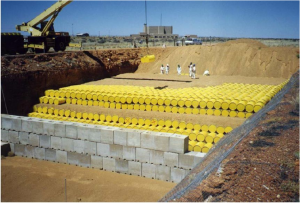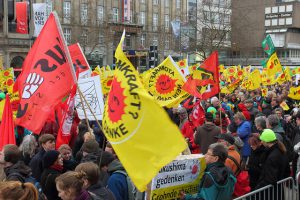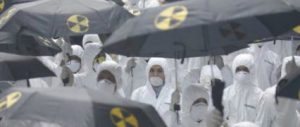Two years after Fukushima, a clearer picture of how the disaster has impacted nuclear power’s prospects is emerging. For some European countries including Germany, Italy and Lithuania, Fukushima was the last straw. Other developed countries, such as the UK and the US, are trying to carry on as if Fukushima has no relevance to them because their designs are different, their operators more competent and tsunamis not a risk. Developing countries seem the least affected and nuclear ambitions in countries such as Turkey, Vietnam and Bangladesh are apparently as they were.
Safety regulators have started to specify required upgrades to existing reactors, and it is no surprise that the newly reformed Japanese watchdog is asking for significant modifications.
More surprisingly, the French safety regulator was Europe’s first and only to issue a list of required significant upgrades, including better back-up power facilities. For new designs, it will be a long time before they reflect all the lessons of Fukushima. Twenty-five years after Chernobyl, the first post-Chernobyl designs have yet to enter service anywhere in the world.
But the nuclear industry faced formidable problems even before the crisis in Japan: the interlinked problems of poor economics, difficulties obtaining finance and doubts about the viability of the new designs expected to power the “Nuclear Renaissance”.
Nuclear construction costs soar
A decade ago, the nuclear industry promised the new generation of reactors, so-called Gen III+, would be safer, but simpler and therefore cheaper and less prone to construction delays, costing no more than US$1,000 per kilowatt of capacity. That would price a 1,000-megawatt reactor at US$1 billion, making nuclear cheaper than natural-gas generation.
While external factors – greater concern about climate change and rising fossil-fuel prices (at least until shale gas started to have an impact) – have moved in favour of nuclear power since then, the economic case has got weaker. Estimated construction costs have increased seven-fold.
The disastrous experience with construction of the first two Gen III+ reactor orders, Olkiluoto in Finland and Flamanville in France, both now running at least four years late and more than 100% over-budget, has badly dented credibility. These both use French company Areva’s EPR design.
The other leading Gen III+ design is the AP1000, belonging to Westinghouse, a US-headquartered company, now Japanese owned. Four were ordered in 2012 in the United States, but even before the first concrete has been poured, there are delays, cost over-runs and quality issues.
The rise of nuclear China
The one bright spot for the nuclear industry in recent years has been the emergence of China as a major market for nuclear power. From 2008 to 2010, construction started on 38 reactors worldwide, a much higher ordering rate than in the previous 20 years. However, of these, 25 were in China, six in Russia and three in Korea.
This change in the balance of the world market was also reflected on the supply side. The traditional western market leaders began to lose orders to these newcomers. Russia became the world’s leading nuclear exporter, gaining orders in Turkey, Vietnam and Bangladesh, while Korea won a major order for the UAE, comprehensively undercutting the bid of French “champion” Areva.
China has yet to win a foreign order (except for two small reactors for Pakistan) but is constantly spoken of as a major new presence in the market. This seems to be on the basis, with no evidence to support it, that because the reactors were from China, they would be cheap but good quality.
The situation in China is more complex than often imagined.
There are three competing nuclear vendors: Chinese Guangdong Nuclear (CGN), Chinese National Nuclear Company (CNNC) and State Nuclear Power Technology Corp (SNPTC). Most of the recent 18 orders have been supplied by CGN using their CPR1000 design – fundamentally a 40-year-old model, long pre-dating the 1978 Three Mile Island nuclear accident in the US.
There was some evidence, even before Fukushima, that the ordering rate in China of up to 10 reactors per year was putting unsustainable strain on the Chinese nuclear supply chain, while the designs being used were acknowledged to be old. So the halt to new reactor construction starts following Fukushima may have been a blessing.
It was also clear to China that it needed to move to more modern designs and it ordered six Gen III+ reactors in 2007 to 2008, four from Westinghouse and two from Areva. This was a major plus for the western vendors because it was expected to provide a shop-window for the new designs and, because it was China, the reactors would be built to time and apparently to cost.
But as the estimated price-tag of these designs escalated, there was an increasing perception that they were too expensive for China. There are also reports of construction delays and cost overruns of about a year with the AP1000s, prompting all three Chinese vendors to talk of developing their own Gen III+ designs. As these are all some way from being orderable, when China lifted its moratorium on new reactor construction projects in November last year, the two projects approved used old technology.
China’s uncertain nuclear future
China is in a difficult position: if it wants to keep its nuclear reactor supply industry busy, it needs a flow of orders. But its new designs are probably several years away from being buildable so it needs to keep ordering the old designs. To secure a place in the world market for nuclear power plants, China will need to go through the lengthy – perhaps five year – process of getting a credible western safety regulator to carry out a comprehensive design review.
Meanwhile, it is exploring alternatives, finally starting the long-delayed Pebble Bed Modular Reactor (PBMR) demonstration plant. PBMR, developed in Germany, has for more than 50 years been seen by devotees as the ideal nuclear technology. But attempts to commercialise it in Germany and more recently in South Africa have come to nothing. Whether China will be more successful in turning its theoretical attractions into a commercial design remains to be seen.
While China is by far the most important market worldwide for nuclear-power plants, nuclear is not important to China and even if it continued to build large numbers of reactors, nuclear power would still supply less than 10% of China’s electricity. The hope from Areva and Westinghouse that China would be a showcase is now fading.
Ultimately, nuclear power can only survive if it is competitive with the alternatives. Unless the trend of sharply rising real costs can be reversed, this will not be the case. Financiers are reluctant to finance new nuclear plants unless the costs of any problems could be passed on to electricity consumers because of nuclear power’s poor track record. At worst, this will make new nuclear projects impossible to finance. At best, it will make the cost of borrowing high, pushing the cost of nuclear power even higher.




